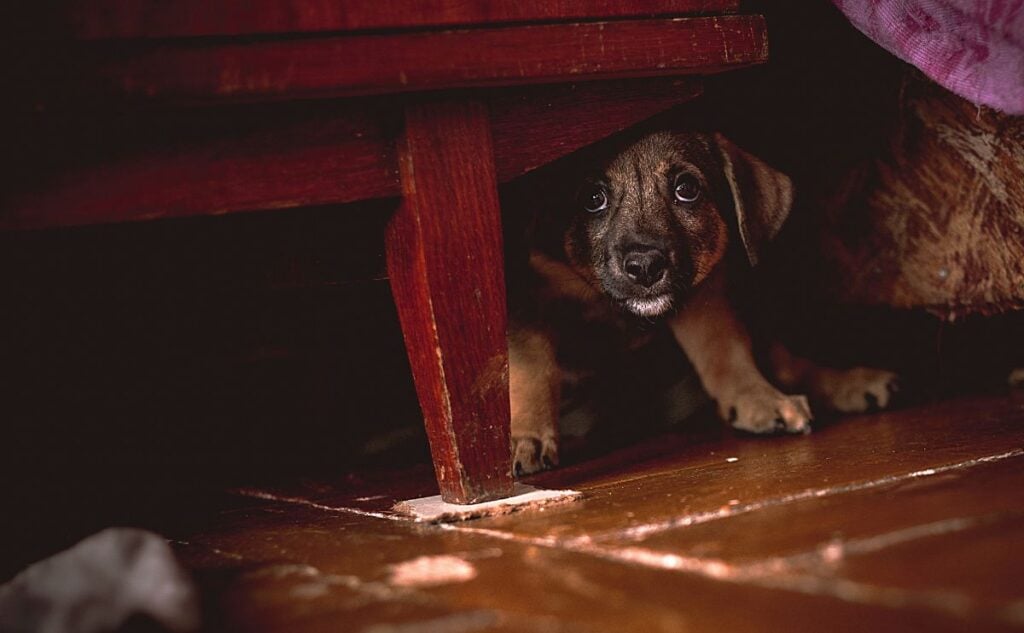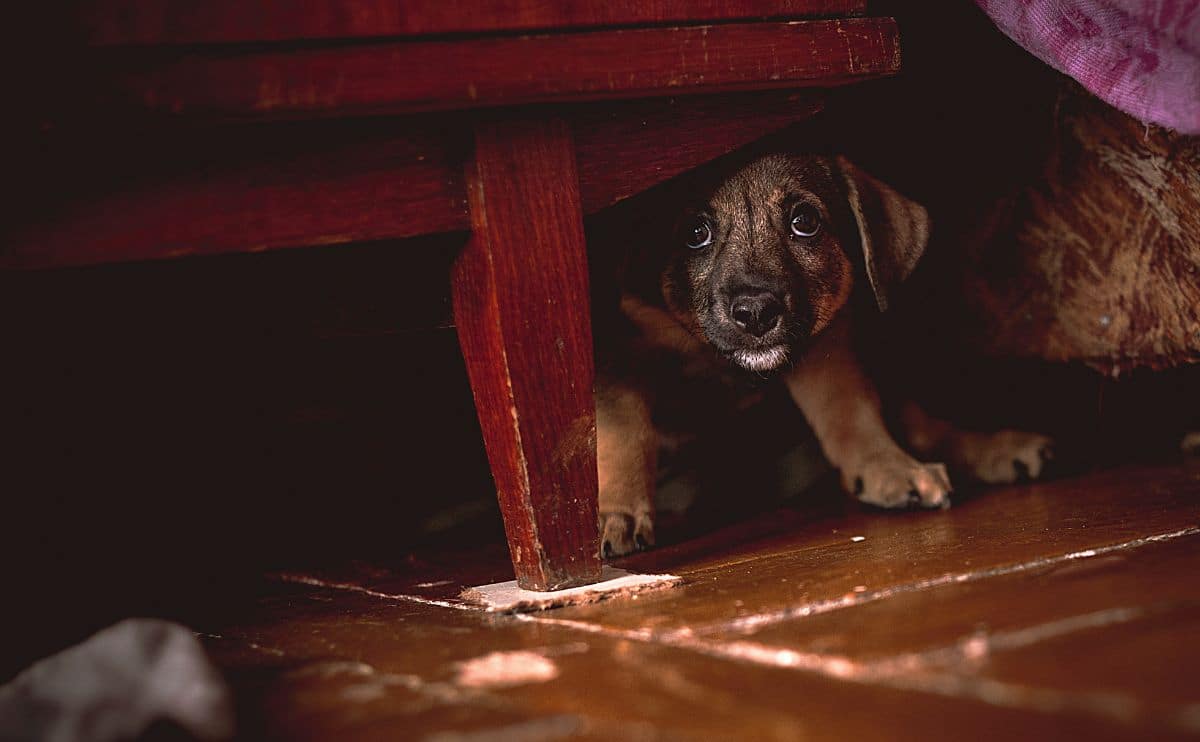Welcoming a new puppy into your home is an exhilarating and fulfilling journey. Yet as they mature, you might notice abrupt shifts in their behavior—once-confident, inquisitive pups may suddenly grow hesitant, startled, or fearful of things they previously found comfortable. This transformation, while surprising, is a natural part of their development called the puppy fear period.
Though challenging for both puppies and owners, understanding fear periods helps provide the right support to nurture a confident, well-adjusted companion. Here’s a guide to what they are, the two key stages, how to manage them, and breed-specific considerations to help your pup navigate these sensitive phases.

Image credit: evgengerasimovich, Shutterstock
What Are Puppy Fear Periods?
Puppy fear periods are developmental stages where young dogs become acutely sensitive to new experiences, people, or environments. These phases, typical in the first year, see puppies react with skittishness, anxiety, or avoidance to stimuli that once caused no concern. Common signs include sudden fear of familiar objects, hiding, excessive barking, hesitation to move, or seeking extra reassurance.
During these times, puppies’ brains are highly impressionable as they learn to navigate the world. While alarming, this is normal—their emotional and cognitive growth makes them more aware, yet less equipped to handle novel situations than adult dogs.
2 Common Puppy Fear Stages

Puppies experience two primary fear periods, each tied to critical developmental milestones. Recognizing these stages allows for targeted support to build resilience.
1. First Fear Period: 8–11 Weeks
Occurring during the tail end of the 3–14 week socialization window, this phase marks the start of self-awareness. Puppies may suddenly fear sounds, people, or objects they once ignored. Negative experiences here can leave lasting imprints—for example, a loud noise might create a lifelong aversion. Gentle, positive exposure to new stimuli during this time is key to fostering confidence.
2. Second Fear Period: 6–14 Months
As puppies enter adolescence, hormonal and physical changes trigger a resurgence of fear. Previously confident pups may grow anxious around strangers, larger dogs, or new places. This stage reflects their struggle to understand their role in the world, often leading to re-emerged fears of car rides, public spaces, or unfamiliar dogs.
How Long Do Puppy Fear Periods Last?

Fear periods typically last days to weeks, though duration varies by breed, temperament, and past experiences. The first period, shorter and during peak socialization, often resolves quickly with positive handling. The second, tied to adolescence, may fluctuate over months, influenced by maturity rate and environmental factors.
Why Duration Varies
Breed plays a role—larger breeds mature slower, extending their second fear period. Individual sensitivity also matters; shy pups may take longer. Positive early experiences help shorten these phases, while limited socialization or trauma can prolong them.
Training Through Fear Periods
Puppies in fear periods are building trust in their environment, making calm, positive interactions vital. Avoid overwhelming them or punishing fear—instead, reinforce confidence with gentle exposure and rewards. Their intense emotional responses stem from underdeveloped coping skills, so patience and reassurance are key.
Turning Fear Into Positive Learning

Fearful moments offer growth opportunities. By prioritizing gradual exposure and positive reinforcement, you can help your puppy build resilience. Here’s how:
1. Respect Their Space
Let your puppy retreat from stressors. Tucked tails or backing away signal discomfort—allowing them to observe from a distance prevents panic.
2. Reward Calm Engagement
Praise and treats for calm curiosity (e.g., glancing at a scary object) teach positive associations. Reassurance-seeking (looking to you) should also be rewarded to strengthen trust.
3. Let Them Lead
Never force closer contact. Let your puppy decide when to approach, rewarding small steps like sniffing or tail-wagging to build confidence.
4. Keep Sessions Short & Fun
Focus on small progress—even a hesitant sniff counts. End on a positive note with treats or play to reinforce good experiences.
5. Stay Calm & Casual
Dogs mirror your emotions. Act unconcerned about the stressor, redirecting with toys or play to help them relax.
Fear Periods Across Breeds

While all puppies experience fear periods, intensity and triggers vary by breed. Here’s how different groups may react:
Guardian & Working Breeds
Breeds like German Shepherds, bred to be alert, may have pronounced second fear periods as protective instincts develop. Controlled socialization is key to prevent reactivity.
Herding Breeds
Border Collies and Corgis, highly sensitive and aware, may react intensely to sudden changes. Their quick learning can prolong fear periods if not managed gently.
Toy & Small Breeds
Chihuahuas and Pomeranians, physically vulnerable, may show more intense fear. Gradual exposure and extra patience help build confidence.
Sporting & Retriever Breeds
Labradors and Goldens, typically outgoing, may have milder fear periods. Reward-based training works well due to their eagerness to please.
Sighthounds & Primitive Breeds
Greyhounds and Shibas, independent by nature, may withdraw. Gentle encouragement and avoiding forced interactions are critical.
Key Takeaways

- Stay calm—puppies sense your anxiety. - Each puppy is unique; genetics and experiences shape their response.
Frequently Asked Questions
Navigating fear periods can raise questions. Here are answers to common concerns:
Can Bad Experiences Have Long-Term Effects?
Yes—traumatic events during fear periods may cause lasting anxiety. Prioritize positive or neutral experiences.
Should I Socialize My Puppy During Fear Periods?
Yes, but gently. Focus on controlled, low-stress exposures to avoid overwhelm.
Will My Puppy Outgrow Fears?
Most do, but unaddressed fears may persist. Consistent positive reinforcement helps prevent long-term issues.
When to Seek Professional Help?
Consult a trainer or behaviorist if fear is severe, persistent, or worsening. Early intervention prevents escalation.
Essentials for Puppy Care
Beyond fear periods, a balanced diet, teething toys, and a safe space (like a playpen) support your puppy’s growth. Preparation with these basics ensures a smooth transition as they thrive through developmental phases.

